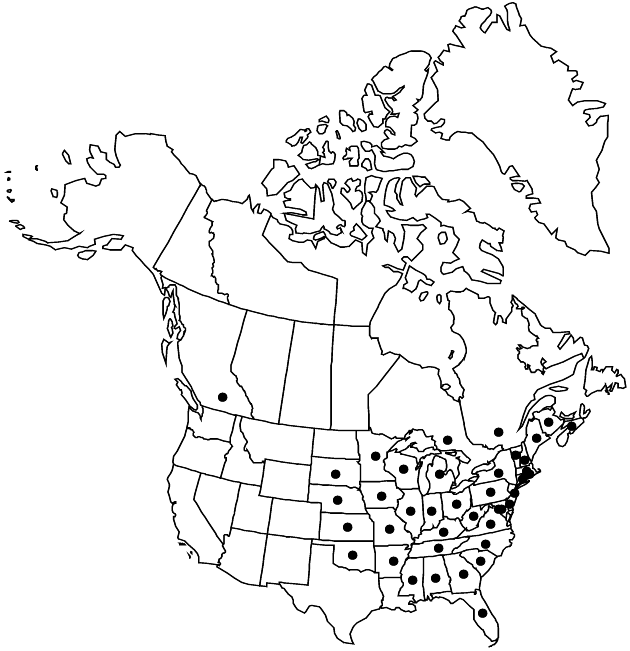Symphyotrichum pilosum
Phytologia 77: 289. 1995.
Perennials cespitose, (5–)20–120(–150+) cm; with stout, branched caudices, sometimes long-rhizomatous. Stems 1–5+, ascending to erect (straight, stout), glabrate to hirsuto-hispid or pilose, sometimes glabrous or hairy in lines (var. pringlei). Leaves thin, margins ciliate, apices acute to acuminate, mucronate, faces glabrous or ± hirsute (particularly on abaxial midveins); basal withering by flowering (new vernal rosettes developing at flowering), petiolate to subpetiolate (petioles winged, ciliate, bases sheathing), blades oblanceolate or obovate to spatulate, 10–60 × 5–15 mm, bases attenuate, margins sparsely crenate-serrate (mostly apically), apices obtuse to rounded; proximal cauline usually deciduous at flowering (often with axillary clusters of small leaves), petiolate or subpetiolate to subsessile (petioles narrowly to broadly winged, clasping), blades elliptic-oblanceolate or -oblong to linear-lanceolate or -oblanceolate, 40–102 × 5–25 mm, progressively reduced distally, bases attenuate to cuneate, ± clasping, margins entire to serrate, softly ciliate, apices attenuate, hyaline-spinulose; distal sessile, blades lance-oblong to linear-lanceolate to linear or linear-oblanceolate or linear-subulate, 10–100 × 1–8 mm, progressively reduced distally, branch leaves abruptly smaller, bases cuneate, margins entire or serrulate. Heads in open, leafy, often pyramidal, paniculiform arrays, branches divaricate or branches 10 cm or less ascending, often arched and secund, sometimes racemiform. Peduncles 5–30(–50) mm, progressively shorter distally, glabrous or densely hispid, bracts 7–25+, appressed to ascending, sometimes ± spreading, linear to subulate, glabrate, ciliate or not, mucronate to apiculate, ± grading into phyllaries. Involucres campanulate to cylindro-campanulate, (2.5–)3.5–5.1(–6.5) mm. Phyllaries in 4–6 series, appressed or slightly spreading, oblong-lanceolate (outer) to linear (innermost) , unequal (rarely subequal), bases indurate 1/2–3/5, margins hyaline, scarious, erose, ± ciliolate distally, green zones lanceolate to lance-rhombic, apices acute or acuminate, involute, spinulose, faces glabrous or sparsely hirsutulous. Ray florets (10–)16–28(–38); corollas usually white, rarely pinkish or bluish, laminae (4–)5.4–7.5(–11) × (0.4–)0.8–1.3(–1.7) mm. Disc florets (13–)17–39(–67); corollas light yellow becoming reddish purple or brown, (2.5–)3–4.1(–5.5) mm, tubes much shorter than narrowly funnelform throats, lobes lanceolate, (0.4–)0.6–0.8(–1) mm. Cypselae whitish or gray, oblong-obovoid, sometimes ± compressed, 1–1.5 × 0.5–0.7 mm, 4–6-nerved, faces sparsely strigillose; pappi white, 3.5–4 mm.
Distribution

B.C., N.B., N.S., Ont., Que., Ala., Ark., Conn., D.C., Del., Fla., Ga., Ill., Ind., Iowa, Kans., Ky., Maine, Mass., Md., Mich., Minn., Miss., Mo., N.C., N.H., N.J., N.Y., Nebr., Ohio, Okla., Pa., R.I., S.C., S.Dak., Tenn., Va., Vt., W.Va., Wis.
Discussion
Varieties 2 (2 in the flora).
The ecology and cytogeography of Symphyotrichum pilosum were summarized by J. G. Chmielewski and J. C. Semple (2001b). The species is often confused with S. ericoides, which inhabits the same kinds of open, prairie-like habitats; the latter can be distinguished by its smaller heads and spine-tipped phyllary apices. Because of that, the name Aster ericoides has been misapplied often in floras and in the horticultural trade.
Selected References
None.
Key
| 1 | Stems sparsely to densely hirsute; leaves pilose; various substrates | Symphyotrichum pilosum var. pilosum |
| 1 | Stems glabrous; leaves glabrous or glabrate; mainly on calcareous substrates | Symphyotrichum pilosum var. pringlei |